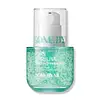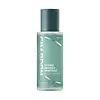What's inside
What's inside
 Key Ingredients
Key Ingredients

 Benefits
Benefits

 Concerns
Concerns

No concerns
 Ingredients Side-by-side
Ingredients Side-by-side

Water
Skin ConditioningButylene Glycol
Humectant1,2-Hexanediol
Skin ConditioningGlycereth-26
HumectantNiacinamide
SmoothingPropanediol
SolventGlycerin
HumectantMethylpropanediol
SolventCaprylic/Capric Triglyceride
MaskingHydrogenated Vegetable Oil
EmollientSodium Polyacryloyldimethyl Taurate
Emulsion StabilisingAcrylates/C10-30 Alkyl Acrylate Crosspolymer
Emulsion StabilisingTromethamine
BufferingEthylhexylglycerin
Skin ConditioningCoptis Japonica Root Extract
Skin ConditioningTetrahydroxypropyl Ethylenediamine
Adenosine
Skin ConditioningDisodium EDTA
Malachite Extract
AntioxidantSpirulina Platensis Extract
Skin ProtectingSodium Hyaluronate
HumectantGellan Gum
Trisodium Ethylenediamine Disuccinate
Agar
MaskingMelia Azadirachta Leaf Extract
Skin ConditioningArginine
MaskingMelia Azadirachta Flower Extract
Skin ConditioningCoccinia Indica Fruit Extract
Skin ConditioningXanthan Gum
EmulsifyingGlycine
BufferingSolanum Melongena Fruit Extract
Skin ConditioningEclipta Prostrata Extract
Skin ConditioningOcimum Sanctum Leaf Extract
Skin ConditioningAmber Powder
Corallina Officinalis Extract
Skin ConditioningCurcuma Longa Root Extract
MaskingMoringa Oleifera Seed Oil
EmollientSimmondsia Chinensis Seed Oil
EmollientSodium Dna
Skin ConditioningGlutamic Acid
HumectantCodium Tomentosum Extract
Skin ProtectingUndaria Pinnatifida Extract
Skin ConditioningSodium Lactate
BufferingCarbomer
Emulsion StabilisingPolysorbate 20
EmulsifyingPorphyra Yezoensis Extract
Skin ConditioningLaminaria Saccharina Extract
Skin ProtectingLaminaria Digitata Extract
Skin ProtectingPalmitoyl Tripeptide-5
Skin ConditioningLaminaria Japonica Extract
Skin ProtectingEnteromorpha Compressa Extract
Skin ProtectingSargassum Fulvellum Extract
Skin ConditioningSargassum Fusiforme Extract
Skin ProtectingPalmitoyl Pentapeptide-4
Skin ConditioningWater, Butylene Glycol, 1,2-Hexanediol, Glycereth-26, Niacinamide, Propanediol, Glycerin, Methylpropanediol, Caprylic/Capric Triglyceride, Hydrogenated Vegetable Oil, Sodium Polyacryloyldimethyl Taurate, Acrylates/C10-30 Alkyl Acrylate Crosspolymer, Tromethamine, Ethylhexylglycerin, Coptis Japonica Root Extract, Tetrahydroxypropyl Ethylenediamine, Adenosine, Disodium EDTA, Malachite Extract, Spirulina Platensis Extract, Sodium Hyaluronate, Gellan Gum, Trisodium Ethylenediamine Disuccinate, Agar, Melia Azadirachta Leaf Extract, Arginine, Melia Azadirachta Flower Extract, Coccinia Indica Fruit Extract, Xanthan Gum, Glycine, Solanum Melongena Fruit Extract, Eclipta Prostrata Extract, Ocimum Sanctum Leaf Extract, Amber Powder, Corallina Officinalis Extract, Curcuma Longa Root Extract, Moringa Oleifera Seed Oil, Simmondsia Chinensis Seed Oil, Sodium Dna, Glutamic Acid, Codium Tomentosum Extract, Undaria Pinnatifida Extract, Sodium Lactate, Carbomer, Polysorbate 20, Porphyra Yezoensis Extract, Laminaria Saccharina Extract, Laminaria Digitata Extract, Palmitoyl Tripeptide-5, Laminaria Japonica Extract, Enteromorpha Compressa Extract, Sargassum Fulvellum Extract, Sargassum Fusiforme Extract, Palmitoyl Pentapeptide-4
Water
Skin Conditioning1,2-Hexanediol
Skin ConditioningPorphyra Yezoensis Extract
Skin ConditioningButylene Glycol
HumectantGlycerin
HumectantPentylene Glycol
Skin ConditioningSodium Dna
Skin ConditioningEthylhexylglycerin
Skin ConditioningMethylpropanediol
SolventPotentilla Anserina Extract
Skin ConditioningPolyquaternium-51
Skin ConditioningAvena Sativa Kernel Extract
AbrasiveCynara Scolymus Leaf Extract
Skin ConditioningBeta-Glucan
Skin ConditioningHydrogenated Lecithin
EmulsifyingCamellia Sinensis Leaf Water
MaskingPropanediol
SolventSucrose Distearate
EmollientCaprylic/Capric Triglyceride
MaskingHydroxypropyl Cyclodextrin
MaskingBetaine
HumectantCoptis Japonica Root Extract
Skin ConditioningTromethamine
BufferingSodium Polyacrylate
AbsorbentCarbomer
Emulsion StabilisingTocopherol
AntioxidantAdenosine
Skin ConditioningDisodium EDTA
Sodium Hyaluronate
HumectantMaltodextrin
AbsorbentHydrolyzed Gardenia Florida Extract
AntioxidantCollagen
MoisturisingLeuconostoc/Radish Root Ferment Filtrate
AntimicrobialLactobacillus Ferment
Skin ConditioningHydrolyzed Sodium Hyaluronate
Skin ConditioningAllantoin
Skin ConditioningHydroxypropyltrimonium Hyaluronate
Sodium Acetylated Hyaluronate
HumectantHydrolyzed Hyaluronic Acid
HumectantHyaluronic Acid
HumectantSodium Hyaluronate Crosspolymer
HumectantPotassium Hyaluronate
Skin ConditioningCodium Fragile Extract
Skin ConditioningCaulerpa Lentillifera Extract
Squalane
EmollientWater, 1,2-Hexanediol, Porphyra Yezoensis Extract, Butylene Glycol, Glycerin, Pentylene Glycol, Sodium Dna, Ethylhexylglycerin, Methylpropanediol, Potentilla Anserina Extract, Polyquaternium-51, Avena Sativa Kernel Extract, Cynara Scolymus Leaf Extract, Beta-Glucan, Hydrogenated Lecithin, Camellia Sinensis Leaf Water, Propanediol, Sucrose Distearate, Caprylic/Capric Triglyceride, Hydroxypropyl Cyclodextrin, Betaine, Coptis Japonica Root Extract, Tromethamine, Sodium Polyacrylate, Carbomer, Tocopherol, Adenosine, Disodium EDTA, Sodium Hyaluronate, Maltodextrin, Hydrolyzed Gardenia Florida Extract, Collagen, Leuconostoc/Radish Root Ferment Filtrate, Lactobacillus Ferment, Hydrolyzed Sodium Hyaluronate, Allantoin, Hydroxypropyltrimonium Hyaluronate, Sodium Acetylated Hyaluronate, Hydrolyzed Hyaluronic Acid, Hyaluronic Acid, Sodium Hyaluronate Crosspolymer, Potassium Hyaluronate, Codium Fragile Extract, Caulerpa Lentillifera Extract, Squalane
 Reviews
Reviews

Ingredients Explained
These ingredients are found in both products.
Ingredients higher up in an ingredient list are typically present in a larger amount.
1,2-Hexanediol is a synthetic liquid and another multi-functional powerhouse.
It is a:
- Humectant, drawing moisture into the skin
- Emollient, helping to soften skin
- Solvent, dispersing and stabilizing formulas
- Preservative booster, enhancing the antimicrobial activity of other preservatives
Adenosine is in every living organism. It is one of four components in nucleic acids that helps store our DNA.
Adenosine has many benefits when used. These benefits include hydrating the skin, smoothing skin, and reducing wrinkles. Once applied, adenosine increases collagen production. It also helps with improving firmness and tissue repair.
Studies have found adenosine may also help with wound healing.
In skincare products, Adenosine is usually derived from yeast.
Learn more about AdenosineButylene Glycol (or BG) is used within cosmetic products for a few different reasons:
Overall, Butylene Glycol is a safe and well-rounded ingredient that works well with other ingredients.
Though this ingredient works well with most skin types, some people with sensitive skin may experience a reaction such as allergic rashes, closed comedones, or itchiness.
Learn more about Butylene GlycolThis ingredient is an emollient, solvent, and texture enhancer. It is considered a skin-softener by helping the skin prevent moisture loss.
It helps thicken a product's formula and makes it easier to spread by dissolving clumping compounds.
Caprylic Triglyceride is made by combining glycerin with coconut oil, forming a clear liquid.
While there is an assumption Caprylic Triglyceride can clog pores due to it being derived from coconut oil, there is no research supporting this.
Learn more about Caprylic/Capric TriglycerideCarbomer is a polymer of acrylic acid. Its main role is to create a gel consistency.
A high amount of carbomer can cause pilling or balling up of products. Don't worry, most products contain 1% or less of carbomer.
Coptis Japonica Root Extract, also known as Japanese Goldthread, is a traditional East Asian herb. It is prized for its anti-inflammatory, antioxidant, and antimicrobial properties.
That’s not all - research in the International Journal of Cosmetic Science found that its active compound, berberine, may help reduce fat accumulation and slow down fat cell development.
This makes it a promising ingredient for slimming and anti-cellulite products!
Learn more about Coptis Japonica Root ExtractDisodium EDTA plays a role in making products more stable by aiding other preservatives.
It is a chelating agent, meaning it neutralizes metal ions that may be found in a product.
Disodium EDTA is a salt of edetic acid and is found to be safe in cosmetic ingredients.
Learn more about Disodium EDTAEthylhexylglycerin (we can't pronounce this either) is commonly used as a preservative and skin softener. It is derived from glyceryl.
You might see Ethylhexylglycerin often paired with other preservatives such as phenoxyethanol. Ethylhexylglycerin has been found to increase the effectiveness of these other preservatives.
Glycerin is already naturally found in your skin. It helps moisturize and protect your skin.
A study from 2016 found glycerin to be more effective as a humectant than AHAs and hyaluronic acid.
As a humectant, it helps the skin stay hydrated by pulling moisture to your skin. The low molecular weight of glycerin allows it to pull moisture into the deeper layers of your skin.
Hydrated skin improves your skin barrier; Your skin barrier helps protect against irritants and bacteria.
Glycerin has also been found to have antimicrobial and antiviral properties. Due to these properties, glycerin is often used in wound and burn treatments.
In cosmetics, glycerin is usually derived from plants such as soybean or palm. However, it can also be sourced from animals, such as tallow or animal fat.
This ingredient is organic, colorless, odorless, and non-toxic.
Glycerin is the name for this ingredient in American English. British English uses Glycerol/Glycerine.
Learn more about GlycerinMethylpropanediol is a synthetic solvent and humectant.
As a solvent, it helps dissolve other ingredients, helping to evenly distribute ingredients throughout the product. This ingredient has also been shown to have antimicrobial properties which makes it a preservative booster.
Methylpropanediol is able to add a bit of moisture to the skin. It also helps other ingredients be better absorbed into the skin, such as salicylic acid.
Learn more about MethylpropanediolWe don't have a description for Porphyra Yezoensis Extract yet.
Propanediol is an all-star ingredient. It softens, hydrates, and smooths the skin.
It’s often used to:
Propanediol is not likely to cause sensitivity and considered safe to use. It is derived from corn or petroleum with a clear color and no scent.
Learn more about PropanediolSodium DNA is an emerging anti-aging ingredient.
It is created by taking deoxyribonucleic acid (DNA) and purifying it with sodium hydroxide.
The DNA is extracted from several different animal sources, including: calf thymus, the gonadic tissue of a male sturgeon, or herring / salmon sperm.
You have probably seen this ingredient in anti-aging skincare. But what is it?
DNA is composed of nucleotides, or chemical building blocks. Nucleotides include adenine (A), thymine (T), guanine (G), and cytosine (C). Talk about a flashback to biology! Nucleosides are formed from these nucleotides.
The science behind Sodium DNA is based on an ingredient called Polydeoxyribonucleotide or PDRN.
PDRN are DNA fragments mainly extracted from the sperm cells of trout or salmon. Meaning, PDRN can be derived from Sodium DNA.
PDRN consists of chains of nucleotides and nucleosides mentioned above. They can range anywhere from 80 - 2000 pairs.
Studies show PDRN has the following properties:
Most of the research on PDRN has been done using injectable forms. That’s important, because PDRN is a large molecule and doesn’t absorb well through the skin. So if you’re applying it topically, the effects are likely to be much milder.
Still, topical Sodium DNA is emerging as a trendy anti-aging ingredient. It’s generally well-tolerated and offers good biocompatibility with human skin, making it a low-risk addition to most routines.
Further studies are needed to truly confirm this ingredients anti-aging ability (Remember, retinol has decades of research!).
When using this ingredient, is is best to ask a brand about the source of their Sodium DNA. You'll want to find products where the Sodium DNA is sourced from fish. Some Sodium DNA is derived from calf / cow thymus.
Needless to say, this ingredient is not vegan.
Learn more about Sodium DnaSodium Hyaluronate is hyaluronic acid's salt form. It is commonly derived from the sodium salt of hyaluronic acid.
Like hyaluronic acid, it is great at holding water and acts as a humectant. This makes it a great skin hydrating ingredient.
Sodium Hyaluronate is naturally occurring in our bodies and is mostly found in eye fluid and joints.
These are some other common types of Hyaluronic Acid:
Learn more about Sodium HyaluronateTromethamine helps balance the pH and improve the texture of a product. It is synthetically created.
As an emulsifier, Tromethamine prevents oil and water ingredients from separating. This helps stabilize the product and elongate a product's shelf life. Tromethamine also makes a product thicker.
Tromethamine helps balance the pH level of a product. Normal pH level of skin is slightly acidic (~4.75-5.5). The acidity of our skin is maintained by our glands and skin biome. Being slightly acidic allows our skin to create an "acid mantle". This acid mantle is a thin barrier that protects our skin from bacteria and contaminants.
Oral Tromethanmine is an anti-inflammatory drug but plays the role of masking, adding fragrance, and/or balancing pH in skincare.
1,3-Propanediol, 2-amino-2-(hydroxymethyl)-
Learn more about TromethamineWater. It's the most common cosmetic ingredient of all. You'll usually see it at the top of ingredient lists, meaning that it makes up the largest part of the product.
So why is it so popular? Water most often acts as a solvent - this means that it helps dissolve other ingredients into the formulation.
You'll also recognize water as that liquid we all need to stay alive. If you see this, drink a glass of water. Stay hydrated!
Learn more about Water